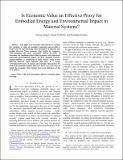| dc.contributor.author | Gregory, Jeremy | |
| dc.contributor.author | Fredholm, Susan A. | |
| dc.contributor.author | Kirchain Jr, Randolph E | |
| dc.date.accessioned | 2010-10-14T20:36:24Z | |
| dc.date.available | 2010-10-14T20:36:24Z | |
| dc.date.issued | 2009-07 | |
| dc.date.submitted | 2009-05 | |
| dc.identifier.isbn | 978-1-4244-4324-6 | |
| dc.identifier.other | INSPEC Accession Number: 10749801 | |
| dc.identifier.uri | http://hdl.handle.net/1721.1/59349 | |
| dc.description.abstract | This paper uses economic value metrics to evaluate the retention of value of secondary materials and provides a framework for characterizing value throughout a material and product life-cycle. These economic value metrics are compared with analogous life cycle assessment metrics in order to determine the conditions under which economic value effectively represents environmental impact for EoL material recovery decision-makers. A comparison of these metrics using several different material types indicates that there is a strong correlation between LCA metrics and economic value metrics for most of the materials studied. However, there were a few cases in which the economic value metrics were poor indicators of the LCA metrics. | en_US |
| dc.language.iso | en_US | |
| dc.publisher | Institute of Electrical and Electronics Engineers | en_US |
| dc.relation.isversionof | http://dx.doi.org/10.1109/ISSST.2009.5156777 | en_US |
| dc.rights | Article is made available in accordance with the publisher's policy and may be subject to US copyright law. Please refer to the publisher's site for terms of use. | en_US |
| dc.source | IEEE | en_US |
| dc.subject | recycling | en_US |
| dc.subject | Life cycle assessment | en_US |
| dc.subject | metrics | en_US |
| dc.subject | economic value | en_US |
| dc.title | Is Economic value an Effective Proxy for Embodied Energy and Environmental Impact in Material Systems? | en_US |
| dc.type | Article | en_US |
| dc.identifier.citation | Gregory, J., S. Fredholm, and R. Kirchain. “Is economic value an effective proxy for embodied energy and environmental impact in material systems?.” Sustainable Systems and Technology, 2009. ISSST '09. IEEE International Symposium on. 2009. 1-5. ©2009 Institute of Electrical and Electronics Engineers. | en_US |
| dc.contributor.department | Massachusetts Institute of Technology. Department of Materials Science and Engineering | en_US |
| dc.contributor.department | Massachusetts Institute of Technology. Engineering Systems Division | en_US |
| dc.contributor.department | Massachusetts Institute of Technology. Materials Systems Laboratory | en_US |
| dc.contributor.department | MIT Energy Initiative | en_US |
| dc.contributor.approver | Gregory, Jeremy | |
| dc.contributor.mitauthor | Gregory, Jeremy | |
| dc.contributor.mitauthor | Fredholm, Susan A. | |
| dc.contributor.mitauthor | Kirchain, Randolph E., Jr. | |
| dc.relation.journal | IEEE International Symposium on Sustainable Systems and Technology, 2009. ISSST '09 | en_US |
| dc.eprint.version | Final published version | en_US |
| dc.type.uri | http://purl.org/eprint/type/JournalArticle | en_US |
| eprint.status | http://purl.org/eprint/status/PeerReviewed | en_US |
| dspace.orderedauthors | Gregory, Jeremy; Fredholm, Susan; Kirchain, Randolph | en |
| mit.license | PUBLISHER_POLICY | en_US |
| mit.metadata.status | Complete | |
